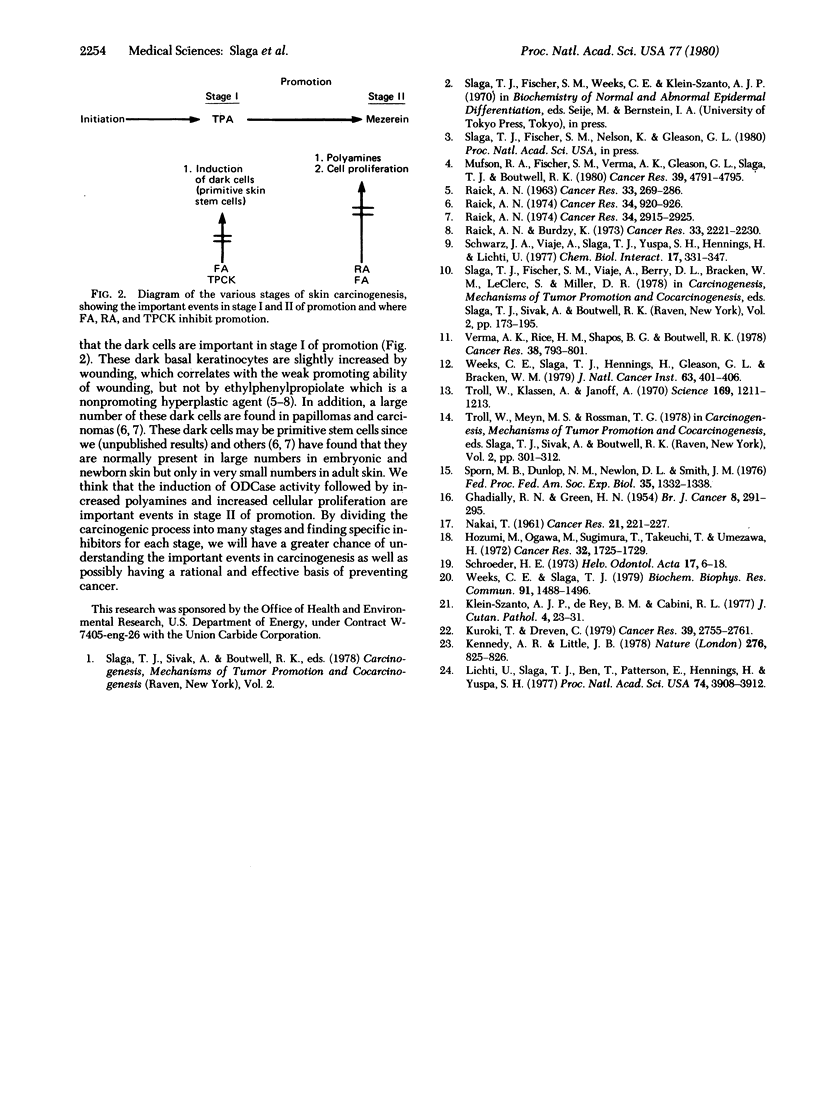Abstract
The effects of fluocinolone acetonide (FA), retinoic acid (RA), and tosylphenylalanine chloromethyl ketone (TPCK) on two-stage promotion after 7,12-dimethylbenz[a]-anthracene (DMBA) initiation in female Sencar mice were investigated. The two-stage promotion protocol was achieved by twice weekly applications of 2 microgram of 12-O-tetradecanoylphorbol 13-acetate (TPA) for 2 weeks (stage I) followed by twice weekly applications of mezerein for 18 weeks (stage II). Separately stage I and II do not cause any tumors to develop after DMBA initiation. FA was found to be a potent inhibitor of stages I and II but to a greater degree for stage I than for stage II. RA was ineffective in stage I but was a potent inhibitor of stage II; TPCK specifically inhibited stage I but not stage II. FA and TPCK effectively counteract the appearance of the dark basal keratinocytes, whereas RA has no effect. These results provide additional evidence for the importance of dark basal keratinocytes in stage I of promotion and indicate that most of the other biochemical and morphological responses normally associated with promotion (such as polyamines) are actually associated with stage II of promotion.
Full text
PDF



Selected References
These references are in PubMed. This may not be the complete list of references from this article.
- GHADIALLY F. N., GREEN H. N. The effect of cortisone on chemical carcinogenesis in the mouse skin. Br J Cancer. 1954 Jun;8(2):291–295. doi: 10.1038/bjc.1954.29. [DOI] [PMC free article] [PubMed] [Google Scholar]
- Hozumi M., Ogawa M., Sugimura T., Takeuchi T., Umezawa H. Inhibition of tumorigenesis in mouse skin by leupeptin, a protease inhibitor from Actinomycetes. Cancer Res. 1972 Aug;32(8):1725–1728. [PubMed] [Google Scholar]
- Kennedy A. R., Little J. B. Protease inhibitors suppress radiation-induced malignant transformation in vitro. Nature. 1978 Dec 21;276(5690):825–826. doi: 10.1038/276825a0. [DOI] [PubMed] [Google Scholar]
- Klein-Szanto A. J., De Rey B. M., Cabrini R. L. Volumetric modifications of X-irradiated keratinocytes. J Cutan Pathol. 1977;4(1):23–31. doi: 10.1111/j.1600-0560.1977.tb00884.x. [DOI] [PubMed] [Google Scholar]
- Kuroki T., Drevon C. Inhibition of chemical transformation in C3H/10T1/2 cells by protease inhibitors. Cancer Res. 1979 Jul;39(7 Pt 1):2755–2761. [PubMed] [Google Scholar]
- Lichti U., Slaga T. J., Ben T., Patterson E., Hennings H., Yuspa S. H. Dissociation of tumor promoter-stimulated ornithine decarboxylase activity and DNA synthesis in mouse epidermis in vivo and in vitro by fluocinolone acetonide, a tumor-promotion inhibitor. Proc Natl Acad Sci U S A. 1977 Sep;74(9):3908–3912. doi: 10.1073/pnas.74.9.3908. [DOI] [PMC free article] [PubMed] [Google Scholar]
- Mufson R. A., Fischer S. M., Verma A. K., Gleason G. L., Slaga T. J., Boutwell R. K. Effects of 12-O-tetradecanoylphorbol-13-acetate and mezerein on epidermal ornithine decarboxylase activity, isoproterenol-stimulated levels of cyclic adenosine 3':5'-monophosphate, and induction of mouse skin tumors in vivo. Cancer Res. 1979 Dec;39(12):4791–4795. [PubMed] [Google Scholar]
- NAKAI T. Influences of small doses of various corticosteroids on the incidence of chemically induced subcutaneous sarcomas in mice. Cancer Res. 1961 Feb;21:221–227. [PubMed] [Google Scholar]
- Raick A. N., Burdzy K. Ultrastructural and biochemical changes induced in mouse epidermis by a hyperplastic agent, ethylphenylpropiolate. Cancer Res. 1973 Oct;33(10):2221–2230. [PubMed] [Google Scholar]
- Raick A. N. Cell differentiation and tumor-promoting action in skin carcinogenesis. Cancer Res. 1974 Nov;34(11):2915–2925. [PubMed] [Google Scholar]
- Raick A. N. Cell proliferation and promoting action in skin carcinogenesis. Cancer Res. 1974 May;34(5):920–926. [PubMed] [Google Scholar]
- Raick A. N. Ultrastructural, histological, and biochemical alterations produced by 12-O-tetradecanoyl-phorbol-13-acetate on mouse epidermis and their relevance to skin tumor promotion. Cancer Res. 1973 Feb;33(2):269–286. [PubMed] [Google Scholar]
- Schroeder H. E. Transmigration and infiltration of leucocytes in human junctional epithelium. Helv Odontol Acta. 1973 Apr;17(1):6–18. [PubMed] [Google Scholar]
- Schwarz J. A., Viaje A., Slaga T. J. Fluocinolone acetonide: a potent inhibitor of mouse skin tumor promotion and epidermal DNA synthesis. Chem Biol Interact. 1977 Jun;17(3):331–347. doi: 10.1016/0009-2797(77)90096-5. [DOI] [PubMed] [Google Scholar]
- Sporn M. B., Dunlop N. M., Newton D. L., Smith J. M. Prevention of chemical carcinogenesis by vitamin A and its synthetic analogs (retinoids). Fed Proc. 1976 May 1;35(6):1332–1338. [PubMed] [Google Scholar]
- Troll W., Klassen A., Janoff A. Tumorigenesis in mouse skin: inhibition by synthetic inhibitors of proteases. Science. 1970 Sep 18;169(3951):1211–1213. doi: 10.1126/science.169.3951.1211. [DOI] [PubMed] [Google Scholar]
- Verma A. K., Rice H. M., Shapas B. G., Boutwell R. K. Inhibition of 12-O-tetradecanoylphorbol-13-acetate-induced ornithine decarboxylase activity in mouse epidermis by vitamin A analogs (retinoids). Cancer Res. 1978 Mar;38(3):793–801. [PubMed] [Google Scholar]
- Weeks C. E., Slaga T. J., Hennings H., Gleason G. L., Bracken W. M. Inhibition of phorbol ester-induced tumor promotion in mice by vitamin A analog and anti-inflammatory steroid. J Natl Cancer Inst. 1979 Aug;63(2):401–406. [PubMed] [Google Scholar]
- Weeks C. E., Slaga T. J. Inhibition of phorbol ester-induced polyamine accumulation in mouse epidermis by anti-inflammatory steroid. Biochem Biophys Res Commun. 1979 Dec 28;91(4):1488–1496. doi: 10.1016/0006-291x(79)91233-6. [DOI] [PubMed] [Google Scholar]


